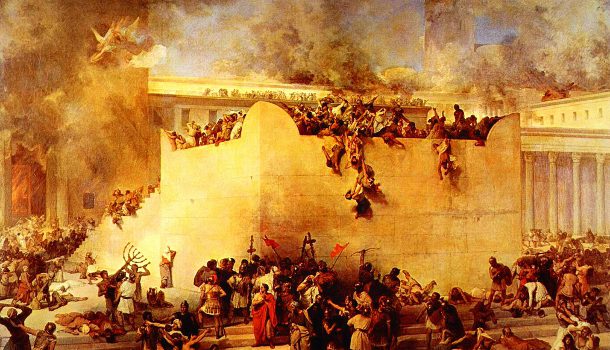Identifying The Abomination of Desolation – A Partial-Preterist Understanding
“Most Bible prophecy interpreters believe that Jesus was referring to the Antichrist who will do something very similar to what Antiochus Epiphanies did. This is confirmed by the fact that some of what Daniel prophesied in Daniel 9:27 did not occur in 167 B.C. with Antiochus Epiphanies. Antiochus did not confirm a covenant with Israel for seven years. It is the Antichrist who, in the end times, will establish a covenant with Israel for seven years and then break it by doing something similar to the abomination of desolation in the Jewish temple in Jerusalem.1” – S. Michael Houdman
“The Antichrist, the man of lawlessness, “the son of destruction, who opposes and exalts himself above every so-called god or object of worship, … takes his seat in the temple of God, displaying himself as being God” (2 Thess. 2:3–4). He is “the one whose coming is in accord with the activity of Satan, with all power and signs and false wonders, and with all the deception of wickedness for those who perish, because they did not receive the love of the truth so as to be saved” (vv. 9–10). That is the abomination of desolation. 2” – John MacArthur
What is the abomination of desolation? According to most Futurist interpretation, in the end times period an Antichrist figure will rise to authority. The Antichrist will make a seven-year peace treaty with Israel, and three and a half years into this agreement, he will break that agreement. Upon breaking this agreement, the Antichrist will enter into a rebuilt third Jewish temple, and there he will reveal himself and claim to be God. Futurist interpreters refer to this displaying or revealing event as the abomination of desolation. Though this seems to be the most popular position taken among Christians today, it suffers from several major exegetical errors. In this article, I will make the argument that a clear reading of the Olivet Discourse reveals that the abomination of desolation should not be understood as something that will have future fulfillment, but rather as something that has already occurred in the past.
Timing The Abomination
The first exegetical error relates to the timing of the abomination of desolation. Futurists like John MacArthur claim that this is an event that must find future fulfillment 3. However, Jesus in Matthew 24:15-34 makes it abundantly clear that this event was something that the generation He was speaking to would see come to pass. He states, “So when you see the abomination of desolation spoken of by the prophet Daniel, standing in the holy place, then let those who are in Judea flee to the mountains. . . Truly, I say to you this generation will not pass away until all these things take place.” The Greek word for generation is γενεά or “genea”. This word is used twenty-seven times in the Gospels, and whenever it is used it always means the contemporary generation that is being spoken to. Jesus was clearly saying thiscurrent generation that he was speaking to would not pass away until they saw the things he was describing take place.
Gary DeMar in his book Last Days Madness affirms this view. He states, “a careful reading of Scripture will show that the abomination of desolation mentioned by Jesus was an event that would be fulfilled during the lifetime of His disciples. 4” Baptist preacher John Gill noted this as well. He wrote, “This is a full and clear proof, that not anything that is said before [v. 34], relates to the second coming of Christ, the day of judgment, and the end of the world; but that all belongs to the coming of the son of man in destruction of Jerusalem, and to the end of the Jewish state. 5” Those who understand this event as something to occur in the future must ignore the clear and literal nature of Jesus words. As DeMar reminds readers, “Jesus said, ‘this generation will not pass away until all these things take place” 6. Thus, the abomination of desolation was something that occurred within the first century, and should not be understood as something that will occur in the future.
Rome Surrounds Jerusalem
Now that the ground work has been laid in regards to the timing the abomination, we will now focus on the identity of the abomination. Not only does Jesus indicate the timing of the abomination of desolation, but he also reveals its identity as well. DeMar notes, “by comparing Luke 21:20-21 and Matthew 24:15-18, we can pinpoint when the abomination of desolation was to appear. 7” Luke under the inspiration of the Holy Spirit writes, “But when you see Jerusalem surrounded by armies, then know that its desolation has come near. Then let those who are in Judea flee to the mountains, and let those who are inside the city depart, and let not those who are out in the country enter it, for these are days of vengeance, to fulfill all that is written.” (Luke 21:20-22 ESV). Luke stated that people would know that Jerusalem’s desolation had come near, when they saw the city surrounded by armies. Did this generation ever see a day when the city was surrounded by armies? As of matter of fact, they did.
In A.D. 62 Vespasian invaded and took Judea 8. Seven years later, Rome surrounded the city of Jerusalem in an identical way as spoken of by Luke. They would overtake and burn the Jewish temple. As the sanctuary of the temple was burning, Roman legionnaires set up symbols of Rome in the temple and offered up sacrifices. DeMar notes, “The Jews would have viewed this action as the fulfillment of Daniel’s vision when the burnt offering ceased and the abomination of desolation was set up. Luke’s description of Jerusalem surrounded by armies, which would have been Roman armies – appears to affirm this theory of a Roman abomination. 9” This event was reminiscent of what Antiochus Epiphanes did to profane the temple and altar more than two centuries before. When Rome overtook Jerusalem, it brought with it many abominations and desolation. This event fits perfectly within the generation time-frame that Jesus mentioned in his discourse.
Answering Objections
One popular objection against the Preterist interpretation of this generation can be seen in the writings of Thomas Ice and Tim LaHaye. Ice and LaHaye claim that Matthew 24:34 should be read this way: “Thegeneration that ‘sees’ these things will not pass till all is fulfilled” 10. DeMar answers this objection in a convincing manner. DeMar writes, “Notice that they substitute ‘the’ for the near demonstrative ‘this’ which changes the focus of the passage from a specific generation – ‘this generation – to any generationbut the generation to whom Jesus was speaking. ‘This’ always refers to something that is near, either in time or distance. 11”.
Another objection to the Preterist interpretation is in regards to the “strong covenant” that the Antichrist will supposedly make with Israel. It is argued that this prophecy could not have found it’s fulfillment in the first century with Rome, because there was not a covenant affirmed with Israel (Dan. 9:27), thus pointing forward to an Antichrist and future fulfillment. This view can be seen in the writings of S. Michael Houdman: “It is the Antichrist who, in the end times, will establish a covenant with Israel for seven years and then break it by doing something similar to the abomination of desolation in the Jewish temple in Jerusalem”. However, this argument is based upon faulty exegesis of Daniel 9:27. Dr. R.C. Sproul notes, that it is the “anointed one” (Jesus Christ) who makes the strong covenant with the people of Israel, not an Antichrist figure 12.
Conclusions
It is clear from reading the text that the abomination of desolation cannot be something that occurs in the future for two reasons. First, Jesus clearly said that “this generation would not pass away until all these things take place” (Matt. 24:34). But most importantly, Jesus identifies the Abomination that causes Desolation as Roman armies that would surround Jerusalem in A.D. 70 and destroy the temple just as prophecied (Luke 21:20-21; Matt. 24:15-18). As noted by Gary DeMar, the Jewish people who lived during this time understood this event to be the abomination of desolation. Conclusively, Thomas Newton in 1755 echoed these same conclusions that we draw in this article: “It is to me a wonder how any man can refer part of the foregoing discourse to the destruction of Jerusalem, and part to the end of the world, or any other distant event, when it is said so positively here in the conclusion, all these things shall be fulfilled in this generation.
Bibliography:
1 Houdman, S. Michael. “What Is The Abomination Of Desolation?” Got Questions. Accessed November 14, 2014.http://www.gotquestions.org/abomination-desolation.html#ixzz3Iysd3e1Ed.
2 MacArthur, John. “The Abomination of Desolation.” Grace To You. Accessed November 14, 2014. http://www.gty.org/resources/bible-qna/BQ012313/the-abomination-of-desolation.
3 See Matthew 24:15 note in the MacArthur Study Bible.
4 DeMar, Gary. Last Days Madness. 4th ed. Powder Springs, Georgia: American Vision Press, 1999. 101.
5 Gill John, An Expostion of the New Testament, 3 vols. London: Matthews and Leigh, 1809. 1:296.
6 DeMar, Gary. Is Jesus Coming Soon?. 3rd Printing. Powder Springs, Georgia: American Vision Press, 2006. 23.
7 DeMar, Gary. Last Days Madness. 4th ed. Powder Springs, Georgia: American Vision Press, 1999. 102.
8 DeMar, Gary. Is Jesus Coming Soon?. 3rd Printing. Powder Springs, Georgia: American Vision Press, 2006. 6.
9 Ibid., 42.
10 LaHaye Tim, Ice Thomas, Charting the End Times: A Visual Guide to Understanding Bible Prophecy. Eugene, OR: Harvest House Publishers, 2000. 1040. see note on Matt. 24:34
11 DeMar, Gary. Is Jesus Coming Soon?. 3rd Printing. Powder Springs, Georgia: American Vision Press, 2006. 24.
12 See Daniel 9:27 Note in the Reformation Study Bible.










